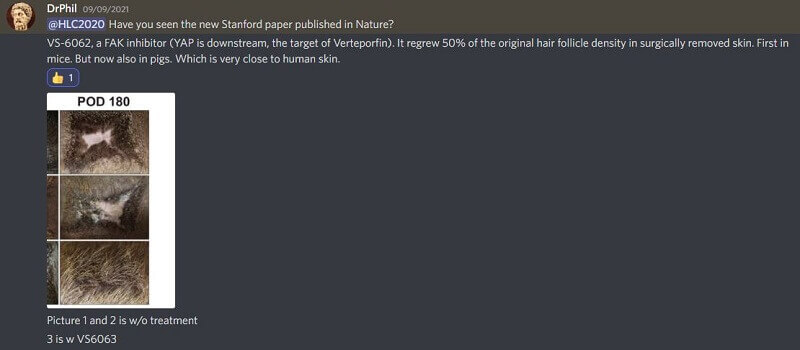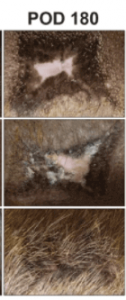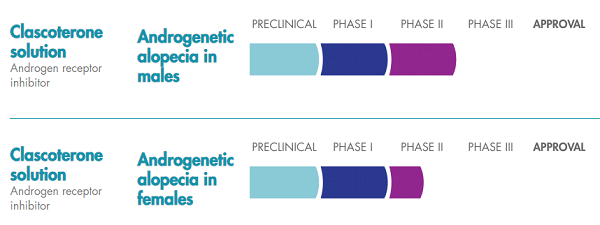April 2, 2023
An encouraging update on Verteporfin and some donor area hair regrowth from Jordan-based Dr. Barghouthi in his interview with the Hair Transplant Network. Still too early to know whether these results are permanent and constantly replicable by other surgeons. And whether any new hair will cycle ok in the long term. But this initiative is really great to see.
Please read my entire original post below for the relevant studies and past videos. It is also possible that FAK inhibitors will be even better than Verteporfin in regrowing hair based on concurrent research findings at the Longaker Lab.
July 24, 2022
It is Verteporfin week in the world of hair loss. More than a year after Stanford’s Longaker Lab findings that Verteporfin injections cause regenerative wound and skin healing in mice. Back then, the news even made it into the NY Times: “Imagine, Surgery Without a Scar.”
Besides the three new recent Verteporfin and hair growth related videos that I mention at the bottom of this post, this week I also got: Verteporfin related emails, blog comments and even a private message on Instagram. I am not as excited as so many people when it comes to the hair regeneration prospects, but this subject is clearly going to remain important in 2022.
Do not Forget FAK Inhibitors
As I mentioned last year in a post, FAK inhibitors might be superior to Verteporfin when it comes to wound healing and hair follicle regeneration. Make sure to also read the comments from Dr. Kellen Chen (one of the FAKI study co-authors) in that post.
See my conversation with one of the Longaker Lab researchers on Twitter in September 2021 regarding both these options. Note that these same scientists (led by Dr. Michael Longaker) published both studies:
- Original Verteporfin study, published in April 2021.
- Original FAK inhibition study, published in September 2021.
Verteporfin and FAK inhibitors both work via the inhibition of the YAP pathway. See part of my conversation with @DrPhil on Discord from last year where he favors the latter over the former:

Also per Dr. Phil:
“This VS-6062 FAK inhibitor does the same thing as verteporfin, but it inhibits a target which is upstream of YAP. Verteporfin only inhibits YAP, while VS-6062 inhibits FAK (which controls YAP) and also other targets. FAK inhibitors can also be applied topically, with no injections required. Moreover, VS-6062 has already gone through Phase 1 and Phase 2 clinical trials to treat cancer.”
Verteporfin Human Clinical Trials
The biggest reason for all this recent excitement is due to the fact that a hair transplant surgeon is finally testing Verteporfin in his patients. Verteporfin (trade name Visudyne) is already FDA approved for photodynamic therapy to treat various eye problems.
Therefore, many people were wondering why we need to wait for the Longaker Lab to begin their human trials (after their pig trials finish). After all, any surgeon can test it out off-label right now. Luckily, we finally have our wishes fulfilled. See the next section with videos further below.
While I am not optimistic on any kind of hair regrowth in the donor region after graft extraction, I would not be surprised at some improvement in wound healing. i.e., the potential for hair transplants with minimal donor scarring in the future.
However, it should be noted that most FUE hair transplants seem to result in acceptable levels of scarring. On the other, FUT (strip) hair transplant still often have very obvious signs of scarring (e.g., see Elon Musk’s hair transplant). Also see my poll results on FUE versus FUT hair transplants.
Three new Videos on Verteporfin and Hair Growth
- On June 21, 2022 Hairliciously published a new video on Verteporfin and hair follicle regeneration.
- On June 22, 2022 Hair Transplant Network published a great interview with Dr. Taleb Barghouthi of the Vertex Hair Clinic in Jordan. He is experimenting with using Verteporfin on his hair transplant patients for one month. If the best case scenario is realized, we would see hair regeneration in the extraction sites and a potentially unlimited donor supply. I am very skeptical, but I liked this interview and Dr. Barghouthi sounds very sincere. Even if the strip or FUE hair transplant scars can be improved via the use of Visudyne, it will be a great achievement. So far, Dr. Barghouthi has seen a delay in healing from sites injected with Verteporfin. According to the video description, this could mean that the pathway that signals the body to being scarring is being blocked.
- On May 17, there was an interesting presentation on verteporfin and its anti-scarring effects by Dr. Heather Talbott (who has conducted years of research on wound healing and scarring). Watch the section between 14 mins and 32 mins in the video.


